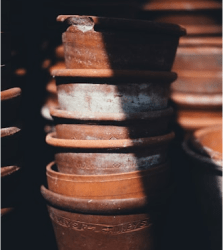By Joma A.
Introduction: A Craft Rooted in History
In many African communities, clay pottery is more than just an art form—it is a symbol of heritage, tradition, and sustainability. Among the most prized creations are coral clay pots, known for their striking reddish hue, durability, and cultural significance. These pots, crafted by skilled artisans, have been used for generations for cooking, water storage, and even ceremonial practices.
However, with the rise of mass-produced alternatives, the craft of making coral clay pots has faced challenges. Yet, in a heartening revival, artisans and cultural enthusiasts are working tirelessly to keep this ancient tradition alive.
The Making of Coral Clay Pots
The process of making coral clay pots is labor-intensive and requires immense skill. The clay, sourced from riverbanks or underground deposits, is mixed with fine sand and sometimes organic materials to enhance its strength. Artisans shape the pots by hand or using a pottery wheel, carefully molding them into their desired forms.
Once shaped, the pots undergo a meticulous drying process before being fired in traditional kilns or open-air fire pits. It is this firing process that gives them their distinctive coral-red hue. Natural pigments or ash finishes may be applied to enhance their aesthetic appeal.
Cultural and Practical Significance
Coral clay pots hold a deep connection to African history and everyday life:
🔸 Water Storage – These pots keep water cool and naturally filtered, making them an eco-friendly alternative to plastic containers.
🔸 Traditional Cooking – Many African households still use clay pots for slow cooking, as they evenly distribute heat and enhance flavor.
🔸 Ceremonial Use – In some cultures, special clay pots are used in weddings, ancestral rites, and religious ceremonies.
Despite modern kitchenware options, many still believe that food tastes better when cooked in a clay pot, reinforcing its continued use in homes and restaurants.
The Revival of African Coral Clay Pots
With growing interest in sustainable living and cultural preservation, African coral clay pots are making a comeback. Artisans and cooperatives are now working together to reintroduce handcrafted clay pottery to global markets.
Key efforts driving the revival include:
✅ Cultural Festivals & Exhibitions – Events celebrating African heritage are showcasing the beauty of coral clay pottery, attracting buyers and collectors.
✅ Online Marketplaces – Many artisans are leveraging e-commerce to reach international customers who appreciate handmade crafts.
✅ Eco-Friendly Movement – As people move away from plastic, traditional clay pots are being recognized as a sustainable and biodegradable alternative.
One such initiative is in Ghana, where female-led cooperatives are using social media to promote their pots. In Nigeria, pottery hubs like Ushafa Village near Abuja are seeing renewed interest from tourists and students eager to learn the craft.
Conclusion: A Future Shaped by Tradition
The revival of coral clay pottery is more than just an economic opportunity—it is a movement to preserve Africa’s rich cultural identity. As younger generations embrace their heritage, the art of pottery-making continues to thrive, blending tradition with modern innovation.
Whether used for cooking, decoration, or spiritual ceremonies, African coral clay pots remain a testament to resilience, craftsmanship, and timeless beauty.
✨ Do you own a traditional African clay pot? Share your experience in the comments!

